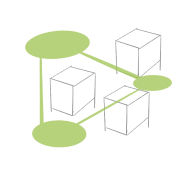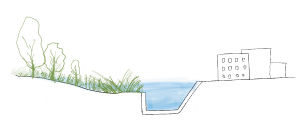Hemsedal City Project: River as Connector
Course: System Oriented Design - Regenerative Design, Design for Democracy, Designing Implementation with Strategies| August-December 2022 | With: Zulunankaer Tuerxun
Hemsedal is a valley surrounded by high mountains on both sides. At the bottom of the valley flows the river Hemsil. The place’s agriculture industry is history and development shifted from agriculture and livestock towards tourism. It lead to Hemsedal being nicknamed "Scandinavia's Alps" for being popular for Winter activities Ski followed by After-Ski. The popularity of the winter Ski and demand in the tourism industry brought city development which has significantly changed the landscape of Hemsedal. Hemsedal is also popular in the summer season, thanks to good fishing opportunities, mountain hiking, mountain climbing, cycling, golf courses and a number of other activities and good accommodation options.
Design Brief
The design scope focuses on the systemic connection of river with the species living systems, development of the city and Hydro-power plants for electricity generation. Impact on this systems to be analysed through GIGA mapping, ZIPP(Zoom points, Ideas, Problems, Potentials) Analysis, Stakeholder Analysis, Desirable and Undesirable future, Stock flows, Impact and Feasibility with the help of Donut Economic model and STEEP Analysis(Social, Technological, Economical, Environmental, Political), Cause and Effect, System Interventions, leverages etc.

Figure(from left to right): Initial GIGA Mapping that includes Hemsedal's city development, Reindeer Habitat red listed species, Hydropower-plant, fishing points, flood zone, current hiking routes, Recycle station, Protected areas, historical and cultural asset and old ruins.


Figure(from left to right): Stakeholder mapping- Hydropower plant, Hemsedal Ecology, River stakeholder, Locals of Hemsedal (also includes animals, plants etc.)
Figure: Timeline- Nature based ecology, Hydropower plants, Urban development and Tourism.

Figure: Map of Hemsedal indicating the locations of Historical building from before 1900s, Coal production plant and catch location, Cultural-historical landscape, Water courses conservation area, Reindeer habitats, Red-listed species.
Problems
1. City is Expanding
Hemsedal's urban development is rapid in the east-west along the banks of the river. Migration of animals and the flood resistance of the river bank have also been affected.
2. Fluctuation on water level
River water is being used by 3 hydropower plants of Hemsedal to produce electricity. It is also used by SkiStar to produce fake snow for Ski, on which tourism is heavily dependent. And it is used by farmers for agriculture and irrigation purposes. The Hemsil River banned fishing for a while this year, and the reason for this is the low water level.
3. Threat to animal habiatat
Skistar area reserves a much larger area than it actually is, and the reserved area includes reindeer habitat and forest conservation areas. Species habitats are therefore threatened.
4. Red listed species
Many red listed species scattered mainly around the river, throughout the triom city, that includes birds, plants, insects.
5. Cultural heritage isn’t their focus
Hemsedal is home to many historical and cultural heritage sites, among which are coal production plant, catching point, historical buildings, and cultural landscape from the past. Lack of awareness around rich local heritage resources.
_edited.jpg)
Figure: It shows how the problems are interconnected to each other and its impact on the species.
Potentials
1. Cultural and historical assets
Hemsedal has cultural and historical assets like many ancient buildings from 1900, former coal mines, fish hunting sites, cultural landscapes, etc.
2. Hiking routes
There are more than 30 hiking trails scattered throughout the Hemsedal but, these hiking trails are not related to each other. It could be categorized/themed based on Hemsedal’s cultural and historical assets.
3. Water level management
Hemsedal water bodies are affected by the fluctuation of water level. Hemsedal can actively guide all sectors to work closely together in water management, and people's awareness of protecting the river will also increase.
4. Conservation area protection
The Hemsedal reserve is adjacent to the rapidly developing skistar, which has also led to varying degrees of development of the reindeer's habitat. Reindeer's habitat could be protected by adjacent areas to create more safe habitats.
5. Urban and ecology
The cornerstone of Hemsedal's development is from their natural resources, so in the current rapid development of tourism, it is necessary to make tourism and the ecological environment in a balanced state of development.
Interventions
Our first two interventions are stepping stones to the main interventions i.e Hiking routes and Ecological Corridor.
1. Workshop at Farmers' Market
Easy place to build a social capital. Presentation of our findings, systemic problems and potentials in form of visual representation with the people of Hemsedal and our stakeholders. Invite volunteers to our booths to discuss about the issues and request for a collaboration to raise awareness and reach. This would follow by a co-design workshop where we us and the vounteers would design some creatives that are specific to our cause. The creatives would be placed around the river.
2. Dinner with major stakeholder
The main purpose for hosting a dinner is to invite the major human stakeholder of the river to discuss about the the on going projects (about the work we did around the river) and discuss how the issue could be solved. We would also invite some of the volunteer, as they are the voices of Hemsedal and the stakeholders need to hear the issues directly from them.

3. Hiking routes
The Hiking route aims to draw attention to the historical and cultural heritage of Hemsedal and to stimulate awareness of the conservation of assets, ultimately creating an effective balance between tourism and ecology. Compared with traditional hiking, the base can realize the mode of combining ecological construction and cultural heritage interaction on a large scale, and the later management adopts the development of scenic spots to carry out a new capital chain, and grasps the data of site heritage, species, water bodies and vegetation, which can achieve sustainable development more scientifically.
4. Ecological Corridor
The deterioration of the ecological environment has threatened the sustainable development of the entire city. Ecological corridors allow humans, wildlife to inhabit and thrive in harmony. Finally, it serves to regulate hydro-logical characteristic, providing resilience to improving the water cycle and future uncontrollable flooding.


Create animal habitats between cities

Implement nature-based built infrastructure


Improve water situations and prevent flooding
Improvement of regional microclimate
Roadmap

Figure: Roadmap with timeline of our intervention journey with ideas, goals, assets, strategies at each stage of our plans.
Final GIGA map
